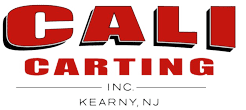Where Does the Tri-State’s Garbage Go?
For homeowners in the Tri-State, once we roll our garbage cans out to the curb twice a week, all of the waste that we produced becomes an afterthought. What we fail to realize is that one our trash is tossed into the back of the garbage truck, that is still has quite a journey to take; one that may take it hundreds of miles by land, rail, or sea. The New York Metropolitan area, which includes all 5 boroughs, Long Island, the Hudson Valley, Northern and Central New Jersey, Western Connecticut, and Northeastern Pennsylvania, has over 26 million residents within its confines. With the average American producing over 1,600 pounds of waste per year, in addition to the thousands of businesses that operate in the Tri-State, it’s safe to ask the question…where does all the trash go?
Garbage By Truck
Around towns, cities, and municipalities throughout New Jersey, New York, Connecticut and Pennsylvania, a fleet of garbage trucks rolls out throughout the neighborhoods almost daily, collecting trash from homes, businesses, government buildings, schools, and more. These trucks are able to collect trash from 400 to 700 homes before having to make the trip to one of the many transfer stations throughout the area, where trucks are unloaded and its contents begin to be sorted out for proper disposal. Once sorted, the trash will end up in one of two places: a landfill, most of which is abandoned mines throughout Pennsylvania, or in an incinerator, which can reduce 100 tons of garbage down to 25 tons of ash and byproduct. The good news about trash that ends up in landfills is that nearly 40 percent of it is organic waste, or food waste, that will naturally decompose quickly.
Image via Lehigh Valley Live
Garbage By Sea
You’d be hard pressed to think of a day where you don’t use something that came in cardboard packaging. The Tri-State region consumes an immense amount of paper and cardboard products, which are all recyclable. High grades of paper that make it into the recycling are collected and sold to paper manufacturers, where they break down the paper and reuse the fibers to make items like tissues or paper towels. Paper products that don’t make the cut to be sold off to these large companies ends up in a compressor, where it’s pressed into one ton cubes and shipped off to China, where prices range from 50 to 60 dollars a pound for a ton of used paper. It’s estimated that over 90 percent of the cardboard consumed in America ends up in China. The Chinese like our paper products because we utilize better fibers, usually from pine, compared to the rice-based paper in China, which can be very thin.
Back to the Consumer
Even take a look at a plastic soda bottle or detergent container? There is a small number printed near the recycling logo somewhere on the plastic container. Each number indicates what grade of plastic the container is made from. When trucks come around for recycling pick-up, the contents of the trucks are sorted and baled based on their grade, then shipped off to companies in Florida, Georgia, and South Carolina where the plastic is broken down and reused to make new items like carpets, textiles, and other plastic items. Other items, like aluminum and glass are also shipped out by truck to companies around North America that can break down the items to a raw material and use it to create new products. As the technology for recycling improves there will be an even bigger demand for recycled goods, so take some time to make an extra effort to ensure that all your recyclables end up in the right bin come garbage day!
Image via Maayboli
The next time you see your neighborhood Cali Carting crew rolling by, be sure to give a wave and say thanks for keeping our communities clean. Could you imagine what a mess the Tri-State would be if garbage companies didn’t exist? Leave us your thoughts in the comments below!



